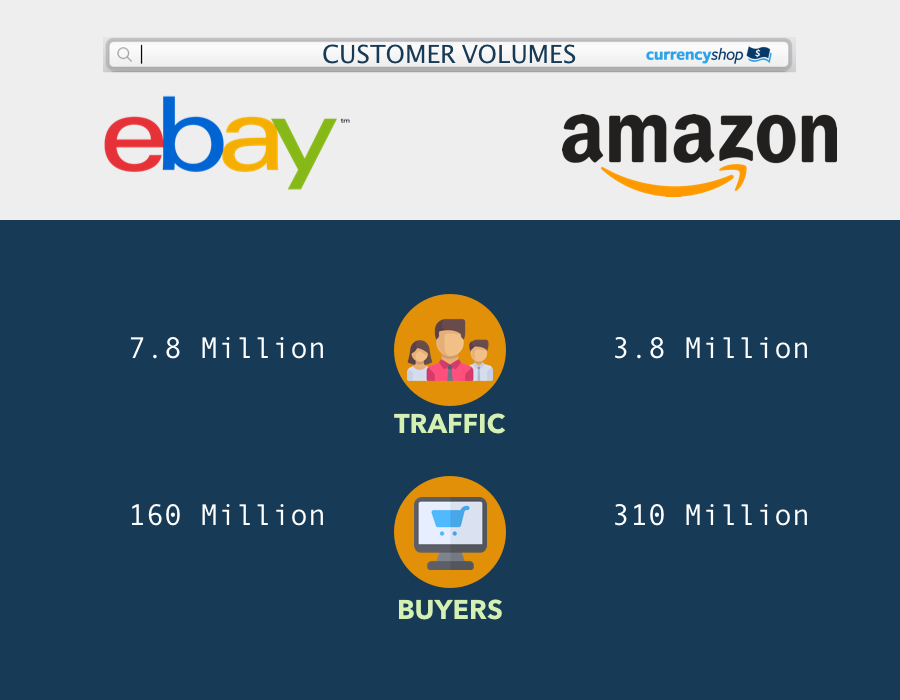eBay Australia vs Amazon – Which one is best for you?
With Amazon landing in Australia, you've now got a greater choice to sell your product online. This article compares eBay and Amazon to help you decide on your online distribution strategy.
eBay Australia has been the ‘go to’ e-commerce marketplace over the past 18 years. It attracts about 8 million Australian visitors per month - double that of Amazon’s online presence. That said, with over 310 million active online customers worldwide, Amazon has more than twice the number of customers and wider reach than eBay – and has now landed in Australia.
When it comes to e-commerce marketplaces, where you decide to sell depends on what you’re selling and the scale of your operation. Selling through your own store has its benefits, but diversifying through an online marketplace can give you exposure and sales from the large volume of traffic.
In fact, many successful sellers take ownership of their brand online with an ecommerce store using Shopify, for example, but also have listings on major online marketplaces like Amazon and/or eBay. It’s important to check the fine print on agreements though, especially in terms of offering items for different prices on different websites.
With this in mind, here is a list of 10 key comparisons between eBay and Amazon to help you with your online distribution strategy:
1. Customer Volumes
On sheer volumes in Australia, it is clear that eBay takes the lead compared to Amazon with about 7.8 million visitors per month versus just 3.8 million visitors for Amazon. But this should change with Amazon looking to expand its fulfilment services domestically, which will likely drive greater volumes of Australian traffic to its website.
On a global basis Amazon leads, with over 310 million active buyers while eBay is home to over 160 million active buyers. This translates into huge potential for acquiring new customers for your products as well as repeat business.
For the moment, existing Australian small business ‘e-tailers’ are more likely to have a standalone personal website combined with an eBay account rather than Amazon – and therefore greater sales from eBay than Amazon…but Australia is also home to many niche e-tailers that just have the single standalone website.
Verdict:
A multichannel strategy will more likely drive greater sales than just a standalone website for brand awareness and access to online customers – so selling on eBay or Amazon or both can be ideal for many e-tailers giving you access to millions of clients.

2. Customer Loyalty and Feedback
The type of buyer and feedback response can differ depending on which e-commerce platform you decide to sell through. Generally speaking, Amazon shoppers tend to love great values (not necessarily at the expense of good quality) and fast, free shipping, while eBay shoppers love high quality items and greater customer service. At the end of the day it’s important to understand the expectations of your buyers no matter which marketplace you decide to sell on.
For feedback, although both Amazon and eBay have a rating system, we think Amazon’s one is easier to see at a glance how many star/feedback ratings the seller has and where the seller stands in terms of ranking. This is important, as it establishes “trustworthiness” – and better trust usually translates to better sales. Despite this, Amazon clients can be pretty bad at leaving feedback, so you have to sell a lot of products to build up a good feedback stream, while eBay customers tend to be better at providing feedback.
On Amazon, buyers tend to expect little to no engagement with sellers, but this has changed in recent years, as Amazon has put more effort into getting shoppers to review their transactions. If your feedback becomes very poor they may suspend your account.
On the flipside, eBay’s interface has always stressed leaving feedback for completed transactions, which has also driven eBay sellers to do their best to maintain impeccable feedback and maintain greater trust between buyers and sellers. This is also probably because on eBay, the feedback score can affect search results, which will make your product more or less visible to shoppers.
Verdict:
Both Amazon and eBay have different types of audiences depending on the product. While eBay has been better at pursuing customer ratings, Amazon is improving, so both platforms are good for building trust with buyers. That said, Amazon is more generic, while eBay allows buyers to check out other products a seller might be selling (better for building a brand for yourself).
3. Speed
Setting up a listing using both platforms is fast – for Amazon it can take just up to a few hours, while for eBay it might only take you up to an hour. That said, due to the style of eBay’s marketplace, you will need to monitor your products and re-list items. There is software designed to help with this, but it takes time and effort.
Amazon also allows sellers selling products already listed on the site to list their product simply by entering in the item’s UPC (universal product code) or SKU (stock keeping unit) number. This process cuts down the time a seller needs to prepare a listing because the relevant information has already been inputted by Amazon employees. However, with Amazon being strict in allowing who can sell and what product can be sold under its Amazon brand, the approval process may hold you back when you want to sell a certain product.
Verdict:
It is quick and easy to set-up products on Amazon and eBay, but there are some potential road-blocks you may need to navigate when you are listing your product.
4. Product Restrictions
Amazon has strict guidelines that you must follow, which include approvals for selling certain products. The list of categories requiring approval appears to be growing and it can be difficult to get approval.
Amazon also works closely with manufacturers and brands. If a brand decides they don’t want third-party sellers listing their items on Amazon, they can deem them restricted at any time. On the flipside, there are no barriers-to-entry on eBay and anyone can sell any item that isn’t on eBay’s restricted list.
Verdict:
It’s important to remember that although marketplaces exist to be mutually beneficial for the buyers and sellers, they also want to help themselves. Like Woolworths or Coles, there is nothing to stop e-commerce marketplace owners from identifying popular products from third-party sellers and stocking and selling it themselves.
5. Payments
Online marketplace fees are tricky to determine. For eBay and Amazon pricing structures are multi-tiered with ‘insertion’ (eBay) or ‘referral’ (Amazon) fees – basically the price to list your product. Plus variable closing fees (post-sale), dependent on item categories, item weights and buyer payment options. Generally speaking, fees are usually deducted as a percentage of each sale.
For eBay Australia, the total cost of selling an item is the Insertion Fee, Final Value Fee plus any optional Listing Upgrade Fees. Every seller gets at least 40 free listings and a flat final value fee of 9.9% of the sale price. The closing fee is based on the total amount paid by the buyer (item price + postage and handling charges). Fee amounts also depend on the selling format (auction-style, Fixed Price or Classifieds) and category (e.g. Media, Collectables, Motors), as well as your ‘Store Package’ (monthly subscriptions), if you have one.
Amazon also has a complex fee structure. The company offers two options for sellers – to be listed as an ‘Individual’ (listing under 40 items per month) or ‘Professional’ (listing over 40 items per month). For Individuals, Amazon charges $0.99 per item to list along with a ‘referral’ fee that ranges from 6-45% depending on the item’s category. On top of that, there is a variable closing fee, which, for BMDV (books, media, DVD and video) items, is not variable at all, but fixed at $1.00 per item. Jewellery and watches are fixed at $2.00 per item. Other products are charged a variable closing fee that is calculated by the item’s weight. If you go the fulfillment by Amazon (FBA) route, Amazon charges an additional weight-dependant fee for picking and packing of orders, shipping and handling, customer service and product returns.
For Amazon, payment is completed by periodic bank transfers to the seller’s account and sellers are protected by Amazon’s Fraud Protection service. Usually payments are deposited every 14 days, which is a longer timeframe than eBay, where you can get paid every day, or even multiple times a day. You can work around Amazon’s bi-weekly payments by request, but it needs to be approved. Amazon doesn’t accept Paypal from buyers yet, but are reportedly in discussions to allow it.
If your account isn’t US-based then you can be subject to additional exchange rate fluctuation fees charged by Amazon (through its currency converter), and potentially your bank so it is important to be aware of these additional costs. eBay sellers usually use Paypal, but they also take additional fees before allowing a user to transfer money to an external bank account.
Verdict:
It is quick and easy to set-up products on Amazon and eBay, but there are some potential road-blocks and costs you may need to navigate and account for when you are listing your product.
6. Customisation
It is certainly easier to personalise your listing using eBay with catchy full-colour ads and photos, compared to Amazon’s neutral listings. According to seller discussion forums, brand names tend to stands out more on eBay than it does on Amazon.
However, both eBay and Amazon restrict sellers from reaching out to buyers and marketing to them. Both forbid any outside links from eBay pages including custom store pages and About Me pages. Saying that, Amazon and eBay allow private labelling – so you can still create a product and put your own private label on it…and now Amazon offers Enhanced Brand Content (it’s like A+ content for vendors, but is free for third-party sellers), which helps you present product information on your listing page to give sellers better branding opportunities.
Verdict:
There is a lack of connection with customers when you use Amazon or eBay, which means it’s tough to set up email lists, promotions, social media or other marketing content. This is another reason why personalising your labels and setting up your own website through a multi-channel strategy might be a good idea if you want to foster your relationship with buyers.
7. Seller Protection
Both eBay and Amazon offer seller protection services with the ability to directly contact a buyer if an issue arises.
Saying that, because many listings on eBay are auctions, it is still easy for fraud to occur. Some ‘false buyers’ harass sellers by bidding on items and refusing to pay if they win. Fortunately, you can invoke a “Second Chance Offer” or pass the item along to the next highest bidder if the first one falls through.
For Amazon, all items are one-click purchases, so they don’t run into this problem. However, most Amazon sellers have the view that when it comes to dispute resolutions, Amazon tends to favour the buyer – particularly with it’s A-Z guarantee and ratings, even if the buyer is dodgy.
Verdict:
It is prudent to include an refunds/returns cost when you are evaluating your fees – these are the usual “costs of doing business”. But it is also always good to research the returns and refunds policy for both marketplaces and seller forums to see what the dispute resolution process is and how to best deal with fraudulent buyers.
8. Analytics
Analytical selling tools provided by eBay and Amazon tends to comes up a bit short. eBay has options for shop analytics and seller success tips, but only for those willing to pay. On the other hand, social media integration, shop analytics and tips for seller success are missing altogether if you’re selling on Amazon. There are external companies that offer tools you can pay to get better customer information more easily, which may be a better option for you if you want to grow your business.
Verdict:
At least eBay has the option to purchase analytical tools to grow your business, but if you’re using Amazon, using external analytical services is the way to go.
9. Infrastructure
Amazon’s infrastructure has a few advantages over eBay. The site makes a buyer feel they are buying directly from Amazon. Purchases can be made using “1-click buying” and, unlike eBay and Paypal, buyers can complete their payment without leaving the site. In addition, Fulfilment by Amazon (FBA) enables the seller to have their items stored and shipped directly from Amazon’s warehouses plus 24/7 customer service, offering a fuller suite of services.
Although FBA is a popular option, it’s not necessarily viable for a seller who’s just starting out by bulk buying products up front. In this regard, eBay might be the more suitable option. Saying that, eBay can sometimes charge outrageous amounts for shipping. On Amazon, the shipping rate is standard for buyers so they don’t feel ripped off, which could be more advantageous for a seller on Amazon. eBay buyers don’t necessarily expect anything beyond what’s directly stated on a listing in terms of shipping times – so as long as you are consistent, you can usually maintain better ratings, trust, and greater sales.
Verdict:
Amazon offers greater service for shipping through FBA, but it may be more expensive. With standardised shipping rates, the economics for buyers may also be more advantageous on Amazon rather than eBay. That said, eBay may be a better platform for sellers who are just starting by bulk-buying items up front or for those who like the flexibility of being in control of their own variable shipping rates to buyers.
10. Competition
Competition on both eBay and Amazon can be brutal depending on the product. Increasingly, large brands and retailers are flocking to eBay and Amazon who purchase items in bulk, so you are likely to be competing with several of them. In addition, Amazon has some competitive private label brands of their own, which will make it even harder for smaller sellers to compete. Some sellers also use automated repricing software so their prices are adjusted to be the lowest price, which can create a downward vacuum in price – great for buyers, but not so great for your margins.
Verdict:
Both platforms are getting more and more competitive for professional sellers, but at least it’s legitimate competition amongst sellers. Finding a niche may be more difficult, but there is still plenty of room for solid private label brands to edge their way into both eBay and Amazon and be profitable.
Final thoughts
When selling through eBay or via Amazon, it’s so important to do your research – ultimately this will help you decide on your online distribution strategy. If you’re not sure which marketplace is best for you, you can test your products and analyse buyer behaviour – stick with one marketplace, figure out how to succeed and then consider others. Or you can use a multichannel strategy and sell products across multiple platforms to maximise profits, but this can be challenging in itself especially in terms of managing inventory.
Whatever strategy you decide on, both Amazon and eBay offer excellent online marketplaces to sell your products and access to customers you otherwise wouldn’t be able to gain exposure to. Good luck!
There is so much to learn about selling on Amazon.
From how to set up your business for success to insider tips and tools, these guides cover every aspect of starting and building a business in the worlds biggest marketplace.











